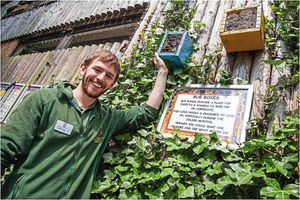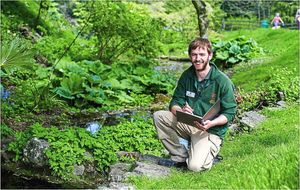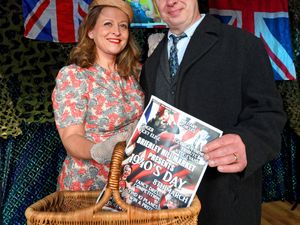Dudley Zoo officer tells of the importance of conservation
Zoos are usually associated with the bigger stars of the natural world and Chris Leeson is not just championing the likes of exotic animals such as tigers and orangutans but also our native species.

From raising awareness of the world's most endangered animals to helping the wildlife we can find in our own gardens – it's all part of a dream job for the conservation officer at Dudley Zoo.
And the 24-year-old is certainly a man on a mission as he believes the attraction has a vital role to play.
"Conservation is very important. We are losing vast amounts of the natural world at an increasingly scary rate.
"Someone has got to prevent that and I think, as a zoo, we have a responsibility to push this conservation message," he says.
Chris, who is a wildlife conservation graduate from the University of Kent, took up the role four months ago.
His career at the zoo actually began with him being a volunteer and a weekend worker before he became a trainee keeper in 2014 and was based at the farm in the primate section.
But his love of all creatures great and small goes back to his childhood when he was inspired by his father's hobby.
"When I was younger my Dad was very keen on nature and I would always go out with him when he went birdwatching or looking for other wildlife so I always knew I wanted to work in conservation," he explains.
Since starting his new job, Chris, who lives in Birmingham, has enjoyed getting stuck into an array of projects around the 40-acre site off Castle Hill.
"There hasn't been a typical day as it's been really varied. I've been looking at wildlife we have on site and setting up projects and schemes for the future," says Chris.
This has included installing night camera traps which have enabled him to capture both badgers and a family of foxes, complete with cubs, on film.
"I really like seeing the badgers on the cameras. The first time I set up the camera traps and saw the work pay off was definitely a highlight for me," says Chris.
As well as families of foxes and badgers, the zoo is also home to many hedgehogs and bats along with different species of moths and butterflies.
His work has also involved him busily forging links with local nature and conservation groups such as Wildlife Trusts.
He also wants to survey the site's population of great crested newts, which are a European Protected Species, as well as focusing on making the ponds more of a feature for visitors.
In July, the zoo signed up to the British and Irish Association of Zoos and Aquariums' (BIAZA) Grab That Gap campaign.

Staff created a mini-meadow for visitors to enjoy by sowing wildflower seeds in an empty patch in front of the peccary, which is from the pig family, enclosure.
The campaign aims to encourage visitors to plant up their own spaces to support native species and highlight how much of a difference even the smallest of areas can have.
Staff have also set up their own 'bug hotel' which has already proved popular with dozens of different critters which have moved in.
"Around the site we have insect hotels and nest boxes and there are signs saying that people can make these at home.
"It's all about encouraging people to look after the wildlife on their doorstep. It's important for them to have information about these too," says Chris.
It's the first time that the zoo has had a full-time conservation officer and Chris is keen to build on the work done in recent years to benefit native species including the Barberry carpet moth, the white-clawed crayfish and the mud snail.
But there are many other ways in which the zoo is making a contribution to nature both at home and abroad.
Some of the success stories from around the enclosures include the Humboldt penguin breeding programme.
As one of the world's rarest penguin species, it is listed as vulnerable to extinction by the World Conservation Union, caused by the depletion of food stocks and climate changes.
Since 1991, thanks to the dedication of keepers to the breeding programme, there have been 183 hatchings and 45 birds sent to find or join breeding groups at 10 other sites around the UK.
Visitors to the zoo can also get involved in dedicated international celebration days which are aimed at highlighting a particular species. Money raised by the events will go directly to help them in the wild.
"We've recently supported World Tiger Day and International Orangutan Day which both help to raise awareness and we will be getting involved in International Red Panda Day. There are a lot of events that we support," says Chris.
In August, staff held an Olympics-themed event in aid of a bid by the World Land Trust to raise £40,000 to preserve a vital piece of forest in Brazil.
Plenty of work, funded by the zoo with the help of its visitors, is also going on overseas.
This has seen the zoo sign up to an education programme on the island of Madagascar, which is the native home of lemurs, to fund nine primary school teachers over a five-year period.
The scheme is run through the AEECL – Association Européenne pour L'étude et la Conservation des Lémuriens.
Based in Sahamalaza National Park, it aims to support the community at the same time as helping people to learn how to protect their local habitats and conserve lemurs in the wild.
"There are a lot of conservation projects that the zoo has been involved in that not many people know about because the zoo has never promoted them but a lot of work goes on behind the scenes.
"As a zoo we are getting people to come in to see the animals but it's very important that at the same time we raise awareness and support conservation to protect these animals and our natural world," says Chris.
By Heather Large




